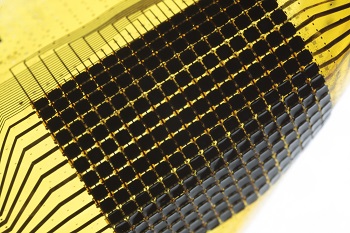
It could be a fun party trick – put your cell phone down on a table and watch it fade into the woodwork – or part of a lifesaving technology used by industry or the military.
Researchers have developed a technology that allows a material to automatically read its environment and adapt to mimic its surroundings. The technology is described in a paper published this week in the Proceedings of the National Academy of Sciences.
Cunjiang Yu, assistant professor of mechanical engineering at the University of Houston and lead author of the paper, said the optoelectronic camouflage system was inspired by the skins of cephalopods, a class of marine animals including octopuses, squid and cuttlefish, which can change coloration quickly, both for camouflage and as a form of warning.
Other researchers on the project include John A. Rogers of the University of Illinois at Urbana-Champaign and Yonggang Huang of Northwestern University.
Earlier camouflage systems didn’t automatically adapt, he said. “Our device sees color and matches it. It reads the environment using thermochromatic material.”
The prototype developed by the researchers works in black and white, with shades of gray, but Yu said it could be designed to work in the full color spectrum. Similarly, he said while the prototype is less than one-inch square, it can be easily scaled up for manufacturing.
The flexible skin of the device is comprised of ultrathin layers, combining semiconductor actuators, switching components and light sensors with inorganic reflectors and organic color-changing materials in such a way to allow autonomous matching to background coloration.
The researchers describe their work as including pixelated devices that include analogs to each of the key elements included in the skin of cephalopods, with two exceptions, the iridophores and central ocular organs.
While the most valuable applications would be for defense or industry, Yu said consumer applications such as toys and wearable electronics also could offer a market for such a technology.
Another possibility? Luxury carmakers now try to give a car’s occupants the sensation that the car has disappeared by deploying cameras to shoot videos on the passenger side of the car and using LED mats to display the view. Yu said this technology could be incorporated for a similar purpose.